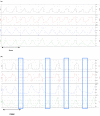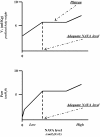Clinical review: Update on neurally adjusted ventilatory assist--report of a round-table conference
- PMID: 22715815
- PMCID: PMC3580602
- DOI: 10.1186/cc11297
Clinical review: Update on neurally adjusted ventilatory assist--report of a round-table conference
Abstract
Conventional mechanical ventilators rely on pneumatic pressure and flow sensors and controllers to detect breaths. New modes of mechanical ventilation have been developed to better match the assistance delivered by the ventilator to the patient's needs. Among these modes, neurally adjusted ventilatory assist (NAVA) delivers a pressure that is directly proportional to the integral of the electrical activity of the diaphragm recorded continuously through an esophageal probe. In clinical settings, NAVA has been chiefly compared with pressure-support ventilation, one of the most popular modes used during the weaning phase, which delivers a constant pressure from breath to breath. Comparisons with proportional-assist ventilation, which has numerous similarities, are lacking. Because of the constant level of assistance, pressure-support ventilation reduces the natural variability of the breathing pattern and can be associated with asynchrony and/or overinflation. The ability of NAVA to circumvent these limitations has been addressed in clinical studies and is discussed in this report. Although the underlying concept is fascinating, several important questions regarding the clinical applications of NAVA remain unanswered. Among these questions, determining the optimal NAVA settings according to the patient's ventilatory needs and/or acceptable level of work of breathing is a key issue. In this report, based on an investigator-initiated round table, we review the most recent literature on this topic and discuss the theoretical advantages and disadvantages of NAVA compared with other modes, as well as the risks and limitations of NAVA.
Figures



References
-
- Esteban A, Anzueto A, Alía I, Gordo F, Apezteguía C, Pálizas F, Cide D, Goldwaser R, Soto L, Bugedo G, Rodrigo C, Pimentel J, Raimondi G, Tobin MJ. How is mechanical ventilation employed in the intensive care unit? An international utilization review. Am J Respir Crit Care Med. 2000;161:1450–1458. - PubMed
-
- Esteban A, Ferguson ND, Meade MO, Frutos-Vivar F, Apezteguia C, Brochard L, Raymondos K, Nin N, Hurtado J, Tomicic V, González M, Elizalde J, Nightingale P, Abroug F, Pelosi P, Arabi Y, Moreno R, Jibaja M, D'Empaire G, Sandi F, Matamis D, Montañez AM, Anzueto A; VENTILA Group. Evolution of mechanical ventilation in response to clinical research. Am J Respir Crit Care Med. 2008;177:170–177. - PubMed
Publication types
MeSH terms
LinkOut - more resources
Full Text Sources
Medical

